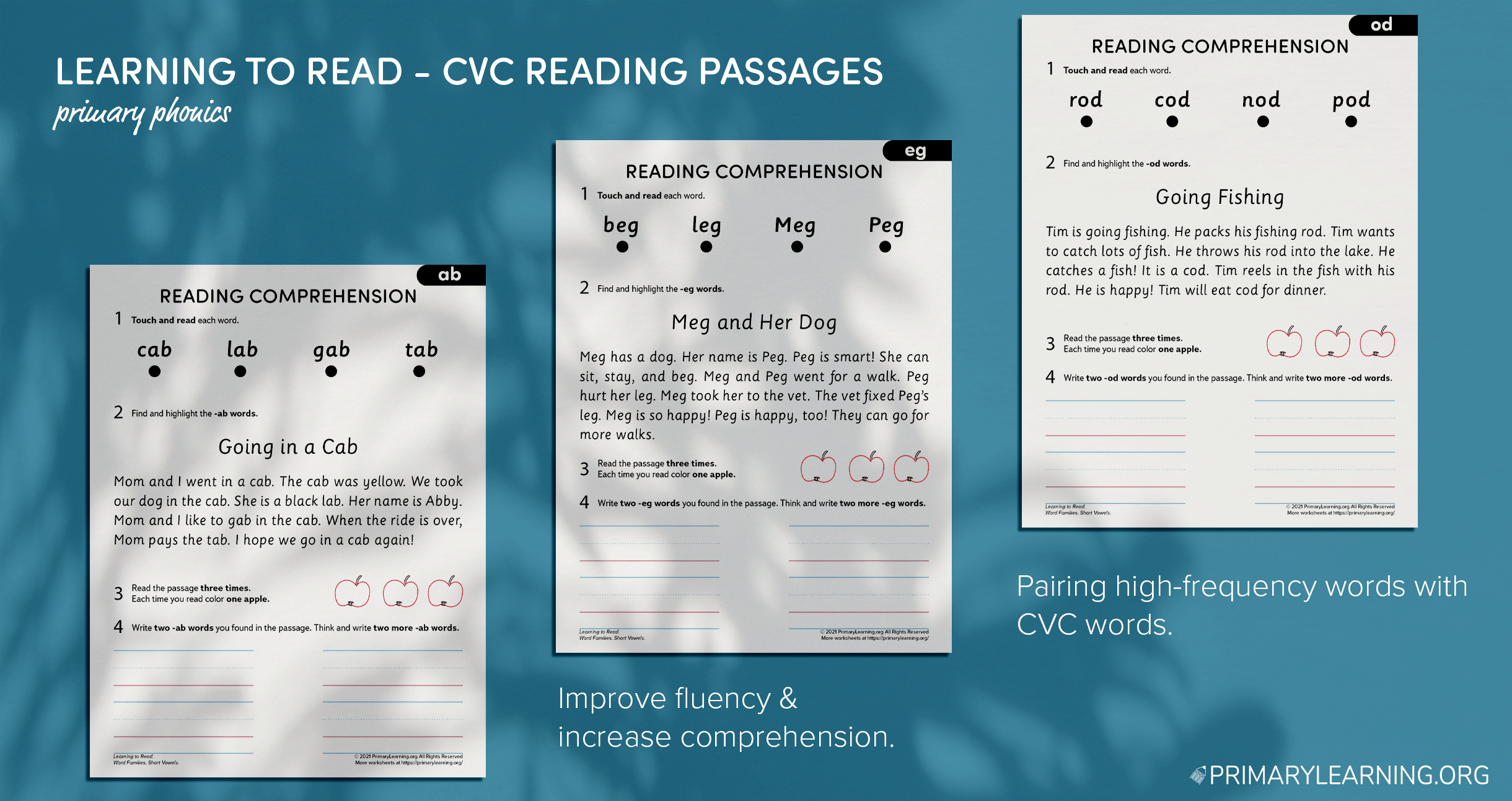

Posted by: Alesia Netuk
Updated: November 20th, 2023
CVC Reading Passages
CVC Reading Passages
Along with CVC words, another excellent starting point for beginning readers is learning high-frequency words, which are also known as sight words. These are words that appear frequently in texts, such as “the,” “a,” and “is.” Many high-frequency words, like “the,” cannot be sounded out and instead, need to be memorized.
As children develop a bank of known sight words, they can begin reading early texts. When this knowledge is paired with CVC words, they can also practice word-solving strategies as they read. The focus of these passages is 1) recalling high-frequency words, and 2) sounding out CVC words.
One way to encourage reading fluency is to have children read passages more than once. Fluency is the ability to read accurately, at an appropriate speed, and with expression. With practice, children can learn to read the words correctly, ensure they are not reading too quickly or too slowly, and add proper expression to their voice. We do not want them frequently stumbling over words, or sounding robotic or monotone. Repetition with a reading passage allows them to practice the skills needed to become a fluent reader.
Reading is a meaning-making experience. This means that reading is not simply saying the words on the page, but also understanding what they mean. As adults, we may be able to read a highly technical text that is not in a field we are familiar with, but we may have limited comprehension of what we just read. This can happen to children, too. We do not want them to read a passage without any understanding of what it meant.
To gauge whether a passage is appropriate for a child, measure not only his ability to read it, but also whether he can correctly answer comprehension questions. You will find that if children are struggling to read a text, their comprehension can break down. They are focusing all their energy on word-solving, and losing the meaning of the text along the way. Choosing “just right” books and passages helps prevent this from occurring and sets children up for success.
AB Word Family Reading Comprehension
AB word family reading comprehension simple story for kindergarten kids! This worksheet has 6 activities, including reading passage and focuses on words ending -ab.
AB Word Family Reading Comprehension
AD Word Family Reading Comprehension
AD word family reading comprehension simple story for kindergarten kids! This worksheet has 6 activities, including reading passage and focuses on words ending -ad.
AD Word Family Reading Comprehension
AG Word Family Reading Comprehension
AG word family reading comprehension simple story for kindergarten kids! This worksheet has 6 activities, including reading passage and focuses on words ending -ag.
AG Word Family Reading Comprehension
AM Word Family Reading Comprehension
AM word family reading comprehension simple story for kindergarten kids! This worksheet has 6 activities, including reading passage and focuses on words ending -am.
AM Word Family Reading Comprehension
AN Word Family Reading Comprehension
AN word family reading comprehension simple story for kindergarten kids! This worksheet has 6 activities, including reading passage and focuses on words ending -an.
AN Word Family Reading Comprehension
AP Word Family Reading Comprehension
AP word family reading comprehension simple story for kindergarten kids! This worksheet has 6 activities, including reading passage and focuses on words ending -ap.
AP Word Family Reading Comprehension
AT Word Family Reading Comprehension
AT word family reading comprehension simple story for kindergarten kids! This worksheet has 6 activities, including reading passage and focuses on words ending -at.
AT Word Family Reading Comprehension
ED Word Family Reading Comprehension
ED word family reading comprehension simple story for kindergarten kids! This worksheet has 6 activities, including reading passage and focuses on words ending -ed.
ED Word Family Reading Comprehension
EG Word Family Reading Comprehension
EG word family reading comprehension simple story for kindergarten kids! This worksheet has 6 activities, including reading passage and focuses on words ending -eg.
EG Word Family Reading Comprehension
EN Word Family Reading Comprehension
EN word family reading comprehension simple story for kindergarten kids! This worksheet has 6 activities, including reading passage and focuses on words ending -en.
EN Word Family Reading Comprehension
ET Word Family Reading Comprehension
ET word family reading comprehension simple story for kindergarten kids! This worksheet has 6 activities, including reading passage and focuses on words ending -et.
ET Word Family Reading Comprehension
IB Word Family Reading Comprehension
IB word family reading comprehension simple story for kindergarten kids! This worksheet has 6 activities, including reading passage and focuses on words ending -ib.
IB Word Family Reading Comprehension
ID Word Family Reading Comprehension
ID word family reading comprehension simple story for kindergarten kids! This worksheet has 6 activities, including reading passage and focuses on words ending -id.
ID Word Family Reading Comprehension
IG Word Family Reading Comprehension
IG word family reading comprehension simple story for kindergarten kids! This worksheet has 6 activities, including reading passage and focuses on words ending -ig.
IG Word Family Reading Comprehension
IN Word Family Reading Comprehension
IN word family reading comprehension simple story for kindergarten kids! This worksheet has 6 activities, including reading passage and focuses on words ending -in.
IN Word Family Reading Comprehension
IP Word Family Reading Comprehension
IP word family reading comprehension simple story for kindergarten kids! This worksheet has 6 activities, including reading passage and focuses on words ending -ip.
IP Word Family Reading Comprehension
IT Word Family Reading Comprehension
IT word family reading comprehension simple story for kindergarten kids! This worksheet has 6 activities, including reading passage and focuses on words ending -it.
IT Word Family Reading Comprehension
OD Word Family Reading Comprehension
OD word family reading comprehension simple story for kindergarten kids! This worksheet has 6 activities, including reading passage and focuses on words ending -od.
OD Word Family Reading Comprehension
OG Word Family Reading Comprehension
OG word family reading comprehension simple story for kindergarten kids! This worksheet has 6 activities, including reading passage and focuses on words ending -og.
OG Word Family Reading Comprehension
OP Word Family Reading Comprehension
OP word family reading comprehension simple story for kindergarten kids! This worksheet has 6 activities, including reading passage and focuses on words ending -op.
OP Word Family Reading Comprehension
OT Word Family Reading Comprehension
OT word family reading comprehension simple story for kindergarten kids! This worksheet has 6 activities, including reading passage and focuses on words ending -ot.
OT Word Family Reading Comprehension
OX Word Family Reading Comprehension
OX word family reading comprehension simple story for kindergarten kids! This worksheet has 6 activities, including reading passage and focuses on words ending -ox.
OX Word Family Reading Comprehension
UB Word Family Reading Comprehension
UB word family reading comprehension simple story for kindergarten kids! This worksheet has 6 activities, including reading passage and focuses on words ending -ub.
UB Word Family Reading Comprehension
UG Word Family Reading Comprehension
UG word family reading comprehension simple story for kindergarten kids! This worksheet has 6 activities, including reading passage and focuses on words ending -ug.
UG Word Family Reading Comprehension
UM Word Family Reading Comprehension
UM word family reading comprehension simple story for kindergarten kids! This worksheet has 6 activities, including reading passage and focuses on words ending -um.
UM Word Family Reading Comprehension
UN Word Family Reading Comprehension
UN word family reading comprehension simple story for kindergarten kids! This worksheet has 6 activities, including reading passage and focuses on words ending -un.
UN Word Family Reading Comprehension
UT Word Family Reading Comprehension
UT word family reading comprehension simple story for kindergarten kids! This worksheet has 6 activities, including reading passage and focuses on words ending -ut.
UT Word Family Reading Comprehension
LEARNING MATERIALS TO MEET EVERY CHILD’S NEEDS
Here, at PrimaryLearning.Org, we tend to deliver the best-differentiated learning materials to K-2 students. Our resources can be easily incorporated into multisensory lessons to meet every child’s needs, whether s/he is a visual, kinesthetic, or auditory learner.